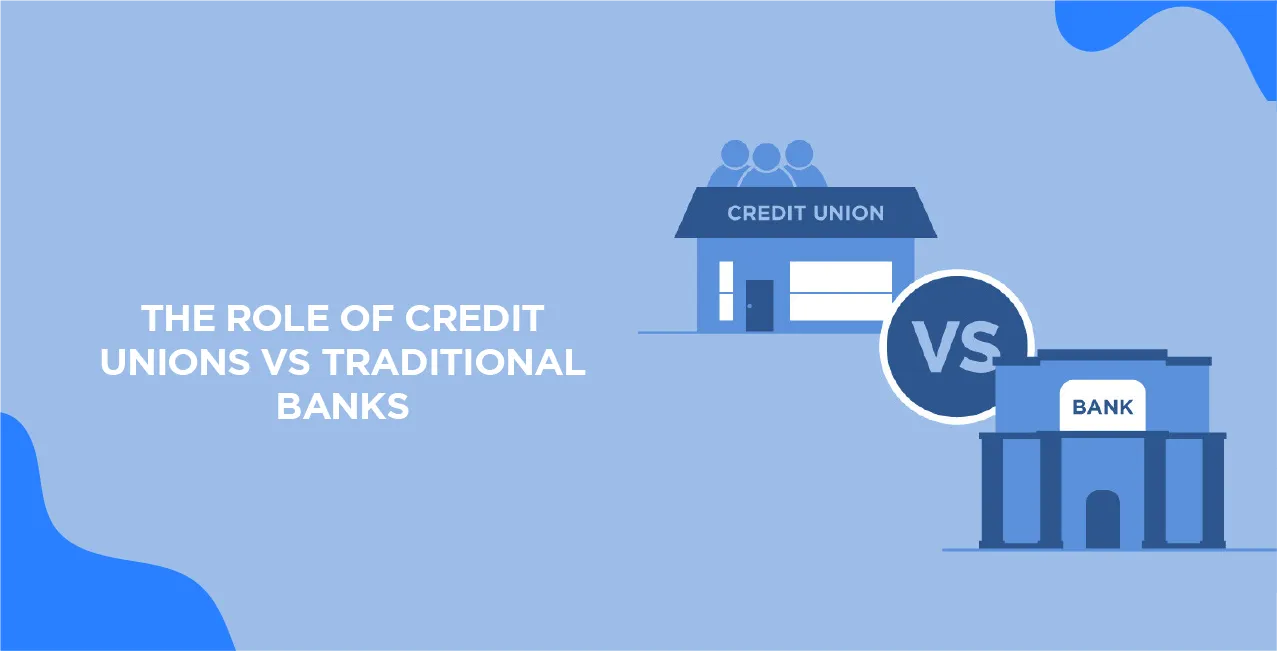
Author
LoansJagat Team
Read Time
4 Min
23 Jun 2025
The Role Of Credit Unions Vs Traditional Banks: Interest Rates And Borrowing Costs
Most of us treat banks and credit unions the same. Both offer loans, savings accounts, and other financial services.
Have you ever considered the difference between credit unions and traditional banks? You can see the difference in how they operate and how much they charge.
One is driven by profit, while the other is built around its members. This difference impacts how much you pay when you borrow and how much you earn when you save.
What Are Credit Unions And Traditional Banks?
Credit Unions are:
- They are member-owned financial institutions.
- Members share ownership of the union.
- They aren’t built for profit.
- They aim to offer budget-friendly financial options to their members.
Traditional Banks work differently:
- They are driven by profit.
- They focus on delivering returns to shareholders.
- Their service charges and loan interest rates tend to be higher.
Main Differences Between Credit Unions And Traditional Banks
Features | Credit Unions | Traditional Banks |
Ownership | Members | Shareholders |
Purpose | Service to members | Profit for investors |
Use of Profits | Reinvested or passed on | Dividends, expansion, or bonuses |
Rate Setting Approach | Cost-based | Market and margin-based |
Interest Rates on Loans | Lower (8% to 12%) | Higher (10% to 16%) |
Interest on Savings | Higher (3.5% to 6%) | Lower (2.5% to 4.5%) |
Customer Focus | Personalised and local | Standardised and broad |
Eligibility | Limited to members | Open to the public |
Interest Rates on Loans: A Game Changer
The biggest difference between credit unions and banks is how much they charge for loans.
Read More – The Right Bank for Your Small Business Needs?
Let’s compare personal loan rates of credit unions and traditional banks for ₹5 lakh loan for 5 years:
Institution Type | Interest Rate | Monthly EMI | Total Interest Paid | Total Repayment |
Credit Union | 10% | ₹10,624 | ₹1,37,440 | ₹6,37,440 |
Traditional Bank | 13% | ₹11,377 | ₹1,82,620 | ₹6,82,620 |
Difference | - | ₹753 less | ₹45,180 saved | ₹45,180 saved |
You can see that by choosing a credit union you can save almost ₹45,000 over 5 years. You can use this amount for many other purposes such as paying for a yearly insurance premium or a school fee.
Example: Home Loan Comparison
Tamanna plans to borrow ₹30 lakh for a home loan over a 20-year period. Let’s compare the home loans of both credit unions and traditional banks for Tamanna:
Institution Type | Rate of Interest | EMI | Total Repayment | Total Interest Paid |
Credit Union | 8.25% | ₹25,530 | ₹61,27,200 | ₹31,27,200 |
Traditional Bank | 9.5% | ₹27,964 | ₹67,11,360 | ₹37,11,360 |
Savings with Union | - | ₹2,434 per month | ₹5,84,160 | ₹5,84,160 |
We can clearly see that by choosing a credit union Tamanna will be able to save around ₹29,000 each year. And over the loan term, she will be able to save around ₹5 lakh.
Why Are Credit Union Rates Lower?
The credit union model involves members pooling resources to offer loans to one another. Since the goal is not to earn profit, they can charge lower rates.
However, according to the bank's working model, profits are distributed to shareholders. That’s why even a 2% higher rate is justified in their model.
Let’s look at an example of earnings from ₹1 Crore Lending:
Institution | Lending Rate | Income Earned | Retained or Paid Out |
Credit Union | 10% | ₹10 lakh | Used for member benefits |
Traditional Bank | 13% | ₹13 lakh | Distributed to investors |
Interest On Deposits: Small Gains That Add Up
Along with lower interest on loans, credit unions provide more attractive rates on savings. In short:
- The interest rate on the loan ⇓
- The interest rate on savings ⇑
Let’s look at savings accounts and FD rates of both credit unions and traditional banks:
Deposit Type | Credit Union | Traditional Bank |
Savings account | 3.5% to 6% | 2.5% to 4.5% |
1-Year FD | 6.5% to 7.5% | 5.5% to 6.25% |
5-Year FD | 7% to 8% | 6% to 6.75% |
Service Fees And Processing Costs
Fee Type | Credit Union | Traditional Bank |
Processing Fee | ₹500 – ₹1,000 | ₹2,500 – ₹5,000 |
Late Payment Fee | ₹0 – ₹250 | 2% of EMI |
Foreclosure Charges | Usually ₹0 | Up to 3% of the balance |
What Should You Choose?
Also Read - The Cheapest Home Loan Offers Following RBI’s 50 bps Rate Cut
You might prefer a credit union if you are looking for:
- Lower borrowing costs
- Higher savings returns
- Low fees
- Personalised support
You might prefer a traditional bank if you are looking for:
- Access to multiple financial products
- Advanced digital banking
- Wider branch network
Final Thoughts
Whether you should choose a credit union or a traditional bank depends on your financial goals. However, credit unions offer a noticeable edge with reduced loan interest and increased deposit returns.
At first, such things might look very small or irrelevant to you but with time the amount grows and a small 1% difference in rate can cost you more than ₹30,000 yearly.
You must compare numbers before taking any of your next financial steps. Ask questions if you have doubts. Explore alternatives so you will choose the best option.
FAQs
1. Is joining a credit union a complicated process?
It is easy to join, with eligibility usually based on your workplace, neighborhood, or community ties.
2. Do credit unions offer business loans too?
Yes, many provide small business and MSME lending.
3. Is it possible to transfer my loan from a bank to a credit union?
Yes, you can do this using a balance transfer, provided you meet the requirements.
4. Do credit unions have mobile banking?
Many offer apps and online services now.
Other Related Pages | ||
Salaried vs Self-Employed: Who Gets the Best Loan Deals in 2025 | Public vs Private Banks: Compare the Cheapest Home Loan Offers | |
About the Author

LoansJagat Team
‘Simplify Finance for Everyone.’ This is the common goal of our team, as we try to explain any topic with relatable examples. From personal to business finance, managing EMIs to becoming debt-free, we do extensive research on each and every parameter, so you don’t have to. Scroll up and have a look at what 15+ years of experience in the BFSI sector looks like.

Quick Apply Loan
Subscribe Now
Related Blog Post


